KS-1 "Comet". The first domestic aviation anti-ship cruise missile
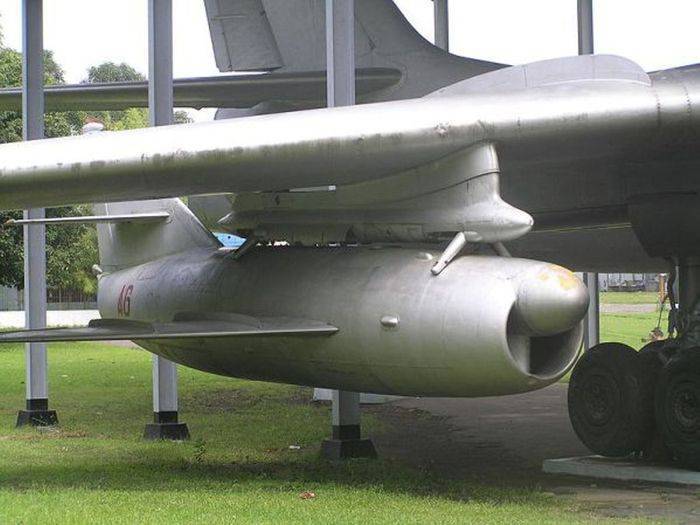
Ustinov warned: "Comrades who will report on the essence of their proposals will come to you. You need to speak exclusively on the research base that is required for their implementation." Two people entered the office - Colonel Engineer aviation and major signalman. Ustinov introduced them to us: "Sergey Lavrentievich Beria and Colonel Kuksenko." Young Beria began to hang posters of the graduation project. So Sergey Beria defended his diploma for the second time with the Minister of Arms. However, this was done not to obtain an estimate for the project, but to consider issues of its implementation. Sergey reported quite well. ” This extensive quote is from the memoirs of comrade S.P. The Queen, the world famous scientist and engineer Boris Evseevich Chertok, is of particular interest as the first mention in the press about the participation in the creation of a guided missile system S.L. Beria.
For many decades, his father, one of Stalin’s most influential associates, was responsible for not only internal organs and intelligence services, but also a number of the most important areas of science and technology, and first of all, the nuclear program.
Sergey Lavrentievich clearly does not deserve scornful attitude. This is evidenced not only by the understandable rapid advance of young Beria on the verge of the forties and fifties, but also by the fact that after considerable ordeal, after the death of his father, he managed to rise to the previous level - already despite, and not because of, origin.
8 September 1947. The Ministry of Arms established Special Office No.1 (SB-1), which is located in the areas of the radar institute - SRI-20.
Pavel Nikolaevich Kuksenko was appointed the head and chief designers of the SB-1, who was the head of the above-mentioned graduation project of S. Beria, who became his deputy in the new organization. The specifics of the SB-1 staff and, even for those years, the organization’s extremely strict "mode" fully confirmed, although not in all years, the formally formalized, but not in popular consciousness, Lavrenty Pavlovich's always inseparable connection with the "organs".
Organizational construction proceeded in parallel with the architectural one — for SB-1, which in August 1950 was converted to KB-1. At the crossroads of the Leningrad and Volokolamsky chasse, a monumental building was built in the size of a whole block, nowadays already divided between a multitude of offices, mostly infinitely far from defense and high technologies.
It is worth noting that the urgent implementation of the project of Sergei Beria to develop a new combat system with guided anti-ship aircraft-shells met an urgent need. Confrontations fleets likely opponents, an order of magnitude superior to the Soviet Navy, and only special attention on the part of the leadership to SB-1 allowed us to create a qualitatively new timely weapon.
Apparently, not one of the famous aviation design bureaus could cope with this task. "Key technologies" lay not in the field of fully mastered the creation of aircraft, but in radio electronics, which neither then nor now gained laurels for domestic science and technology. It is known that the idea of creating controlled weapons for aviation was first implemented by the Germans, who during the Second World War were able to introduce into the series and use the Hs-293 "air torpedo" in battle. Such tasks, but without the use of a jet engine, were solved by actively used German guided bombs. However, these were devices with radio command control. The operator from the cockpit of the aircraft carrier, tracking the target and the guided aircraft, gave a coded signal through the air channel to the cruise missile or gliding bomb via radio channel. The received aerodynamic controls rejected and converted into electrical signals.
These radio-controlled means were used only during the day, with good visibility, in conditions that allowed us to observe the target and a remotely controlled combat aircraft. In the future, systems with radio command control supplemented with radars to track the target. As you can see, they included at least two radio channels - targets and missiles. At the same time, for parallel targeting of several guided aircraft to the target, a corresponding increase in the number of radar channels was required. Most importantly, the pointing accuracy decreased significantly with increasing distance to the target.
On the other hand, some time later, the Americans managed to create a small anti-ship aviation missile “Bat” with an active radar homing system. The extremely modest results achieved with its use in the 1945 year are explained both by the failure of the system itself and by the practical lack of goals for its application. Under the conditions of the complete domination of Americans in the air, the Japanese almost never went to sea. A significant disadvantage of the "Beta" was considered and the small target acquisition range of the active homing head - the transmitter power of the onboard radar was limited by the capabilities and element base of the time.
In the Kometa complex, which was implemented according to Sergey Beria’s graduation project, the only carrier radar served both for detecting and tracking the ship — the target, and for a number of other functions, including targeting the cruise missile at the target through the radar and target illumination for semi-active operation of its homing head.
When the missile was aimed "at the beam," a conical scanning of the axis of the radiation pattern of the aircraft radar was performed relative to the line of sight of the target. Accepting and transforming the modulated signal of this radar in a certain way, the onboard equipment of the rocket determined the magnitude and directionality of the deviation of the projectile from the plane-target line and issued the appropriate commands to the autopilot. In this case, there were no fundamental restrictions on the number of missiles induced on a single target. With an increase in the range to the target, the beam formed by the radar expanded, the pointing accuracy fell, so at the final stage of the rocket’s trajectory a semi-active homing scheme was used along the beam reflected from the target ship. Until the moment of entry into the beam, the rocket flew in accordance with the autopilot program.
Thus, in the combined system, we managed to escape from the shortcomings of both homing, associated with a limited range of target acquisition of a missile launch vehicle, and command guidance with its limitations on the number of channels during salvo firing and low accuracy during long-range launches.
The main characteristics of the Kometa complex and the way in which it was developed was determined by a government decree of 8 September 1947. The radar of the Tu-4 aircraft flying at a height was to detect a typical target - a ship with a displacement of 10000 t - at a distance of at least 100 km. After rapprochement with her on the 60 km, the crew launched a missile plane. The speed of the cruise missile was to be at least 950 km / h.
The development of the Kometa complex itself, as well as the onboard equipment of the missile control, was assigned to the SB-1. The team at NII-17, the leading organization of the Ministry of Aviation Industry in the field of radar, was assigned to develop a guidance system equipment for the aircraft carrier. The cruise missile, which was called “Comet-3” (K-III), was to be created in the OKB-51 Minaviaprom. This bureau, headed by Chelomey, since the mid-forties mastered the German V-1 projectile under the code 10X, and later improved it under the new designation 14X. The sketch of the rocket should have been released in the middle of the year, the onboard equipment for it and the carrier - in the fall of the 1948 of the year, and the systems entirely - by the end of the year.
The decree provided for the creation of "Kometa-3" on the basis of the 10X and 14X projectiles, the range of which significantly exceeded the anti-ship system. It was difficult to ensure the required speed, 1,5 times as fast as the V-1. Therefore, for Kometa-3, a new engine D-1947 was created (in the spring of 7-year), which had a thrust three times greater than the engine of the 10X projectile. For start-ups with Pe-8, an experimental product 14X K-1 was manufactured. On it, in contrast to the standard "Kometa-3", they installed a less powerful pulsating jet engine (RON) D-6. In addition, the experimental rocket differed in the equipment of the SB-1, the autopilot of the company "Ascania", and from the usual 14X - the wing of a larger area. However, the use of PWRD fundamentally limited the speed characteristics of "Comet-3".
Projectile 10X.
In accordance with the August 1948 government decree, the development of the projectile aircraft was transferred to the company A.I. Mikoyan. In the spring of next year, SB-1 from SRI-17 provided the development of equipment for the aircraft carrier. In August, the 1948 of the year was planned that the "Comet-3" will be developed on the basis of the MiG-9. Nevertheless, it was clear that this fighter was too heavy (for a rocket of this class) and had become morally obsolete. As a result, only the RD-1948 engine placed according to the transferred scheme was preserved in the draft 9 of the year from the MiG-20. The air intake was also under the fuselage. The middle wing, like on the MiG-15, had a sweep 35 °. The starting weight was - 2600 kg, and allowed to place up to two airplanes on the Tu-4. The fuel reserve (210 l) made it possible to provide a range of up to 190 km (much longer than the target). However, the TRD RD-20, created on the basis of BMW-003, was unpromising and was soon replaced by a lightweight, reliable and having twice the burden of RD-500.
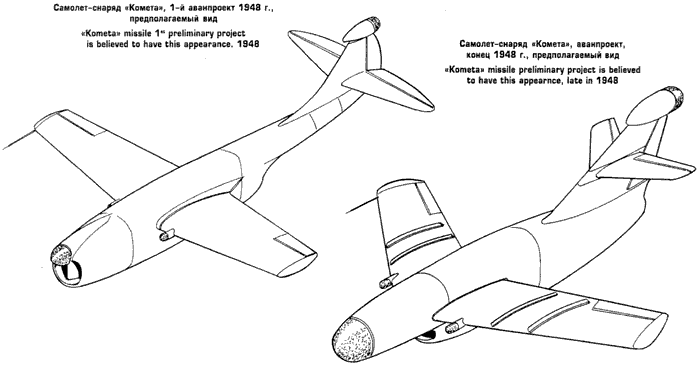
When developing the second draft, released in the 1949 year, the air intake was moved to the nose of the fuselage, placing the radome of the GOS antenna over it in the manner applied later on the MiG-17П. By shifting the center of mass back, they compensated for an increase in the sweep of the wing to 55 ° along the line of foci, while its span was 4,02 m.
Developed under the guidance of M.I. Gurevich cruise missile received the code of the COP, which is deciphered as a "comet-plane" or as a "comet-shell". Externally, looking like a half-and-a-half MiG-15, the projectile aircraft differed from the fighter in a disproportionately small wing, which corresponded to the flight parameters of the CS (it lacked vigorous maneuvering and the entire route passed exclusively at high speed). The carrier surface was designed with a two-jet scheme, and the flight controls were located, as on the MiG-15. The difference from the fighter was the fact that the wing had no mechanization, and the fuselage - the brake plates.
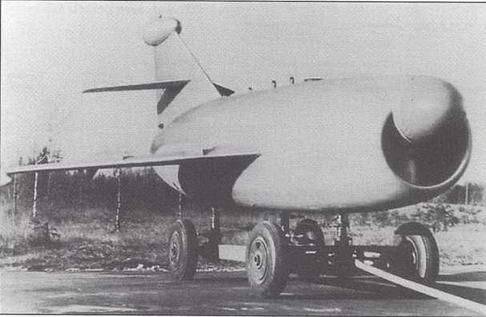
The fuselage of the rocket also practically reproduced that of the MiG-15, but instead of the cockpit of the pilot, it contained equipment for the control system and a warhead. The latter (weighing 1015 kg) was installed on top through a large hatch with a removable lid. Behind the warhead there was a tank 330 liter of fuel, narrowed downwards. Two air channels were connected in front of the RD-500K turbojet engine.
Along with the semi-active GOS placed above the air intake, the onboard equipment included a unit for receiving signals from the aircraft radar. It was located at the tip of the keel and was used during the beam pointing phase. The K-1 equipment, together with the AP-5 autopilot, provided the radar beam from the carrier aircraft, guided along its equisignal zone and, starting from the 10-20 km distance, semi-active radar self-guidance to the target signal from the aircraft station.
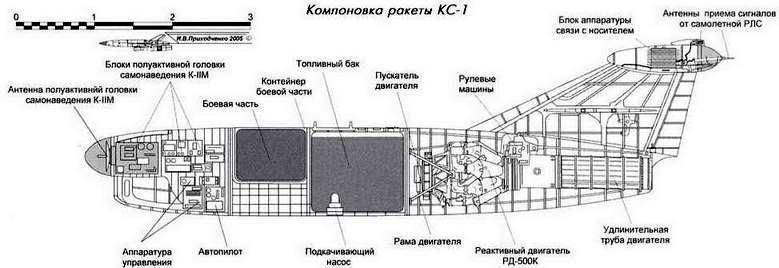
Note that sometimes the characteristics of the “CS” are encountered as reworking the outgoing MiG-15 into a projectile aircraft. Of course, this is a baseless legend. In terms of common design, the “KS” is as close to the MiG-15 as the La-15. You can also MiG-29 considered a reduced copy of the Su-27.
The proximity of the design of the CS to the serial fighter has simplified the creation of a manned modification of the missile, designed to assess the flight characteristics and operation of the onboard equipment, as well as to work out the guidance for a real goal in interaction with the carrier.
A government decree on the development of a manned version of a KS - K aircraft appeared in March 1949. Instead of a warhead, a cramped test-cockpit was mounted, a retractable bicycle scheme chassis was installed, and a full-fledged RD-500 engine with thrust adjustment was installed. Of course, such a transformation was purely experimental in nature - the use of the “Komet” managed “kamikaze” instead of the onboard equipment was, in principle, excluded, since there was no room left for the machine for the warhead. The goal was simpler, as S.L. Beria, "we were able to save both time and hundreds of rockets."
Amet-Khan Sultan made the first take-off on an analogue plane 4 in January 1951. At the same time, they modified the carrier, replaced the Cobalt Radar, a special station Kometa-2 created on its base, and installing pylons on the wing for the suspension of projectiles.
The maximum range of the Cobalt radar reached 400 km. The radar "Kometa-2" additionally ensured the generation of a "sharp beam" of the directional beam pattern. By the beginning of 1951, an experienced Tu-4K was prepared for factory testing. From May 1951 of the year to June, the 1952-th discharged the analogue "K" aircraft from the carrier. They flew first near Moscow, later from the airfield in Bagerov (Crimea), intended mainly for the initial, without atomic explosions, the working off of nuclear bombs. In the sea at Theodosia, the target imitated the former cruiser Red Caucasus, reclassified into a test vessel. The manned analog carried out almost all the operations established for the projectile, including the capture of the GOS target. At a distance of several kilometers from the target ship, the test pilot took control, climbed, and turned on the airfield. In order to avoid getting under the screw Tu-4 before uncoupling the engine thrust was reduced to a minimum, and the manned analogue abruptly lost height, which made it difficult to enter the radar beam.
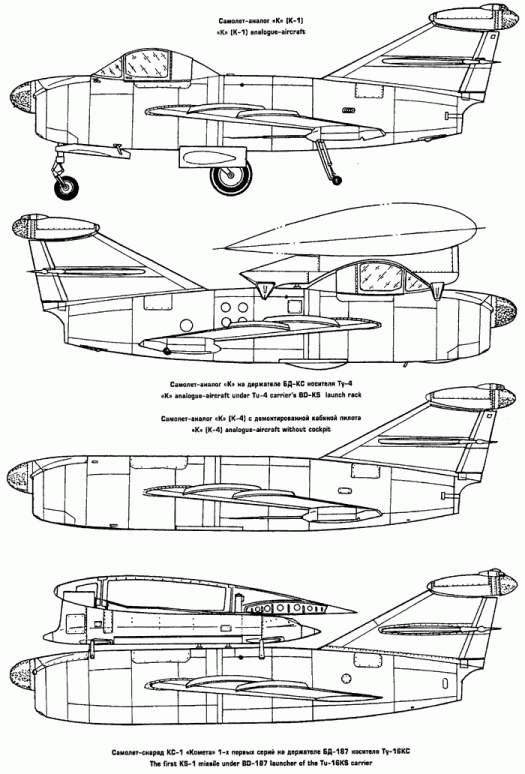
A few years earlier, the initial development of the Kometa instrument began on two Lee-2. One aircraft simulated a rocket, and the second - the carrier. Also, the equipment of the projectile was tested on an experimental FC aircraft (MiG-9L). This modification of the MiG-9 differed from the serial fighter by the receiving antenna mounted at the top of the keel, the antenna of the GOS above the air intake and the operator's cabin with a separate lantern. He was the forerunner of the new MiG-17СДК alternate aircraft used for the development of new systems and the training of crews of aircraft of the CS aircraft.
In the process of testing there were a lot of emergency situations. Because of a droplet of solidified solder that caused the closure of the reset button in the circuit at the very beginning of preparation for disengagement, the K plane, which was piloted by Amet-Khan, involuntarily set off for free flight. A more terrible incident occurred with Burtsev, whose autopilot was not turned off. Barely overcoming the resistance of the steering vehicles, he managed to turn away from the target ship and return to the airfield. There was also a risky private competition between Anokhin and Pavlov - which of the pilots will be able to approach the goal closer and later turn off the autopilot. The danger was the landing, carried out at speeds up to 400 km / h using a bicycle chassis, which is not very stable and unusual for pilots.
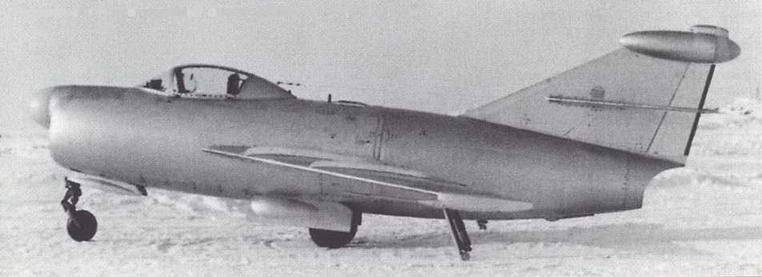
Total 150 performed flights of analogue aircraft, of which 78 accounted for Anokhin. However, the first unmanned flight, made in May 1952, was still unsuccessful. Due to improper installation of the elevators before launch, the projectile did not enter the radar beam. I also had to modify the autopilot, compensated roll.
During the state tests until January, 1953 conducted a successful series of launches. Of the 12 launch aircraft shells, eight hit the target. The most spectacular is the launch of the cruiser "Red Caucasus". As a result of which the glorious guards cruiser sank.
The obtained main technical data of the weapon system significantly exceeded the requirements of the 1947 regulation of the year. The rocket was launched at a distance of up to 80 km from the height of the carrier’s flight to 3000-4000 m and speeds up to 400 km / h. After launch, the carrier reduced the speed to 40 km / h and did not come closer to the target than 40 km. The speed of the projectile reached 1150 km / h.
At the beginning of 1953, the Kometa system was put into service, and its creators and testers received well-deserved awards. Anokhin and Pavlov were given the title Hero of the Soviet Union. It was more difficult to worthily encourage Amet Khan, who had had two Golden Stars of the Hero since June 1945. The appearance in the Soviet Union of the third Thrice Hero was considered premature. So at the end of the trials Amet Khan won the Stalin Prize and received the Order of Lenin.
But some creators of the COP, following well-deserved awards, were attacked by unreasonable punishments. In the summer after L.P. Beria was arrested and his son. Kuksenko, who was not related to them, was removed from his responsible post, graciously sheltered as chairman of the scientific council of KB-1. S.L. Beria had to sit out for quite a few months, lose her awards and honored academic titles, and leave the city for a long time from Moscow. Nevertheless, he found the strength to re-overcome the path from an ordinary engineer to the chief designer. It is noteworthy that in the Khrushchev years, when his real last name was tried at best not to be remembered, the responses of his colleagues were extremely positive.
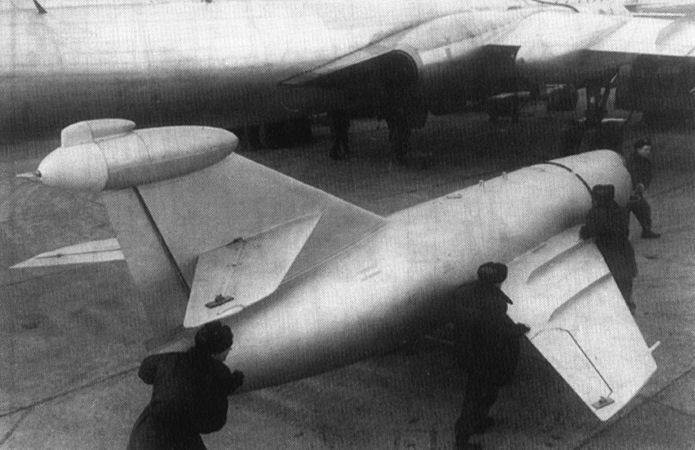
Fortunately, the Comet itself was not proclaimed a pest. At the end of 1952, the projectile was launched into a series at the plant number XXUMX (Ivankovo village, Kalinin region, now Dubna). In the first peaceful years, the OKB-256 was in the territory of this plant, in which German specialists developed an experimental 2 aircraft with a rocket engine. A.Ya. was appointed deputy German chief designer Ressing. Bereznyak. Alexander Yakovlevich still at the beginning of the war in the Design Bureau V.F. Bolkhovitinova together with A.M. Isaev created the first Soviet missile interceptor BI. The activities of the Soviet-German "joint venture" was interrupted after the crash of the 346 aircraft in the fall of 346. The following year, the Germans returned to their homeland, and in Ivankov 1951 in October 11 of the year created a branch of OKB-1951, headed by Bereznyak, who was simultaneously appointed deputy A.I. Mikoyan. In the future, the leading role in fine-tuning, and then in the development of new cruise missiles, was gradually transferred from OKB-155 to its branch.
In a number of publications to the Dubna team and personally A.Ya. Authorship is attributed to Bereznyak in the development of the first domestic cruise missiles, including the CS, although in fact they connected to this topic only at the final stage of development. The talent and achievements of Alexander Yakovlevich are indisputable and will not come from the attribution of others' merits.
Fleet aviators mastered the "Comet" in the Training Part No. 27 near Simferopol. The industry retooled fifty Tu-4s into the carriers of the Tu-4K, which made it possible at the end of August 1955 of the year to begin the creation of the first missile regiment - the 124 of the heavy bombing (from 1957 - mine-torpedo) Black Sea fleet.

Even with 1954, one Tu-16 was equipped with a "Comet", the following year it was tested in Bagherovo. From 1957, the mass-produced TU-16K (TU-16KS, NKS, aircraft "E", product "187") began to flow into the fleet. By 1957, the complex was modified. For ease of operation, a modification of the COP has a folding wing console. Additional fuel volumes made it possible to bring the range to 140-160 km. With 1961, with the introduction of new noise-resistant equipment, it has become possible to target up to eight cruise missiles launched from different carriers.
22 produced 107 of missile-carrying missiles at aircraft plant, which made it possible to form the second missile-carrying part on the Black Sea - the 5 th mine-torpedo regiment, and then the regiments in the Northern and Pacific Fleets. By 1960, there were five regiments of missile-carriers armed with the Kometa in all fleets. They provided combat training to the crews of the carriers of the MiG-17SDK backup aircraft, which were equipped with equipment similar to K-1. The mythical version of the suspension of the manned MiG-17 being carried out under this missile carrier wing does not correspond to reality, if only because it was almost twice as heavy as the CS.
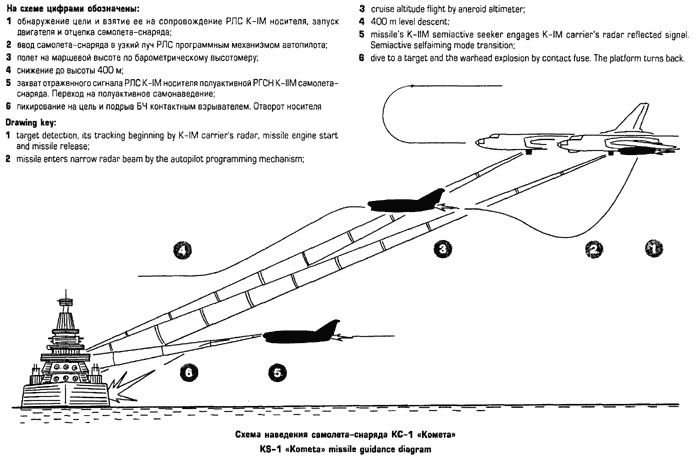
Unlike the mythical storiesIn connection with the war in Korea, the KS really prepared for a real battle a decade later. At the beginning of the sixties, more than two dozen Tu-16Xs and Comet airplanes were sent to Indonesia, which was in conflict with Holland at that time because of the remnants of the colonial possessions. Later this technique was given to the Indonesians. In addition, 20 Tu-16Xs were exported to Egypt, where they did not gain fame - most of the missile carriers were destroyed by the first Israeli attacks at the start of the Six-Day War in June 1967.
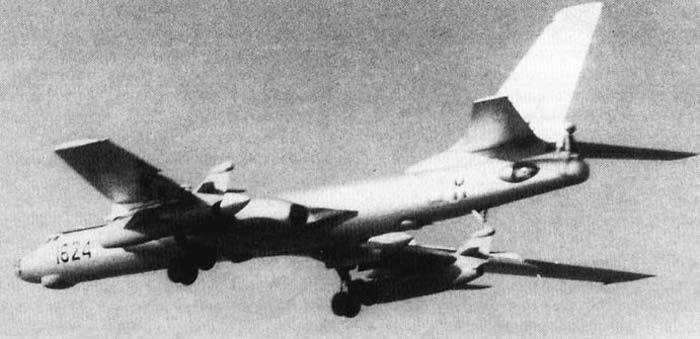
By the end of the 1960-x COP removed from service, and the remaining 65 carriers upgraded to use more advanced systems. Summing up, we will note that the Kometa system became the first Soviet complex of guided missile weapons in history to come into service and ensured the emergence and formation of naval rocket-carrying aircraft, one of the most effective components of the combat power of the Russian fleet.
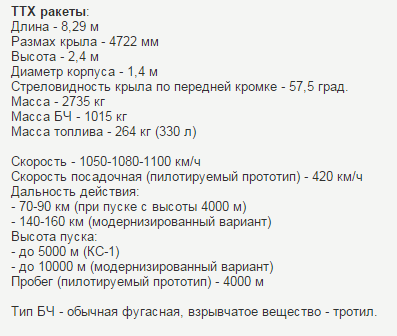
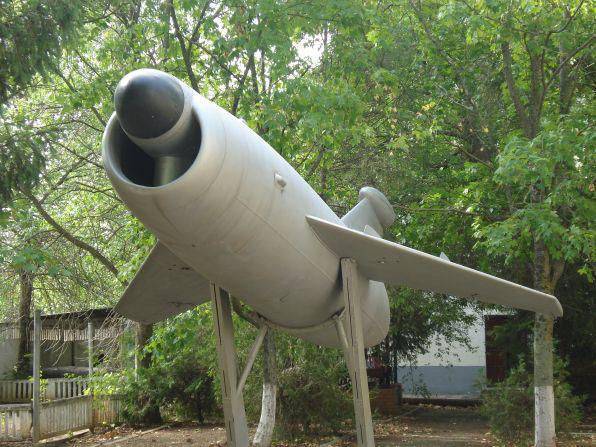
Sources:
Markovsky V., Perov K. The KS-1 rocket complex // Aviation and Cosmonautics. 2005. No.8 C. 1-12.
Kazmin V. “Comet” is almost invisible // Wings of the Motherland. 1991. No.6. C. 17-23.
Yakubovich N. "Comet" has risen to the zenith // Wings of the Motherland. 1995. No.10. C. 8-9.
Angelic R. On the first domestic anti-ship cruise missile KS // Wings of the Motherland. 2002. No.11. C. 8-10.
Shirokorad A. Thunder aircraft carriers // Aviation and Cosmonautics. 1996. No.13. C. 45-47.
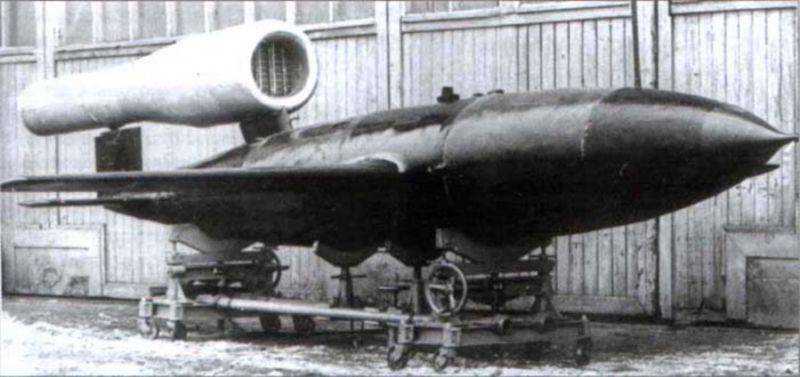
Information